Expeditions: Viking hands-on – blood and betrayal in Viking RPG
A piece of solid RPG is coming from Denmark. Expeditions: Viking will not be a bestseller, but RPG aficionados should watch it closely, as things are looking rather interesting.
- Tactical RPG with strategy elements;
- Successor of Expeditions: Conquistador;
- Emphasis on historical accuracy (no magic);
- Set in Denmark in the 8th century;
- Complex system of character creation and development;
- Tactical, turn-based combat;
- Important role of dialogues and choices;
- Unity engine;
It’s a warm morning in May. Smoke hangs above the village and fire slowly consumes the wooden huts. Dead bodies lie around in the high spring grass. Somebody’s still moving, someone’s death rattle can be heard among the crackling wood. Off in the distance, a drakkar under a white and red sail is lazily sailing away. The Vikings have done their job and are now on their way home. This is essentially the kind of world presented by Logic Artists studio in Expeditions: Viking.
The first installment in the Expeditions series focused on conquistadors, and their conquest of the New World. In the second game by the Danish studio – Viking – the developers invite us to their homeland by setting the game in early medieval Denmark, where players become Viking clan chiefs. As the new boss, the player will have to fight for power, trade with others and organize looting expeditions. I’ve had an opportunity to try the game myself and spend over seven hours in its world, and although I wasn’t too impressed initially, it grew on me with every hour. Expeditions: Viking will not be a game for everybody, but the fans of hardcore RPGs should keep it on their radars – especially those who don’t think graphics are the most important element of a game.
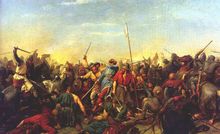
The Vikings wrought havoc in the British Isles between A.D. 800 and 1050, give or take. A symbolic date marked as the beginning of the Viking invasion is A.D. 793, when the monastery at Lindisfarne was ransacked by an organized expedition of Danes. The period of invasions ended in 1066, when king of Norway, Harald III (known as the last Viking) was killed during the Battle of Stamford Bridge (shown on the picture).
You can’t plot without a head
Let’s start with the plot, because it’s clearly going to be the game’s highlight. In Expeditions: Viking, the players are taken to 8th-century Denmark, and assume the role of a young Viking who becomes the chief of their clan after his father’s death. The deceased man wasn’t the greatest leader in the clan’s history, so his death leaves the player in dire straits – many of the local chiefs want to use this situation to their own advantage by trying to lessen our Viking’s influence.
The adventure begins during the wake – friendly small talk soon turns into an argument followed by an outbreak of violence, provoked by one of the neighbors. As soon as we manage to contain the situation (the wayward Erlingr can be spared, exiled or… decapitated), another threat has to be faced head-on: an invasion of oak-tough warriors from Scandinavia. Not to spoil too much: during the first couple of hours the plot revolves around preparations for a looting (or trading – your choice) expedition to the British Isles. As soon as I managed to rally ten warriors, obtain some valuable goods to trade and find proper wood so that a ship builder could fetch me a nice drakkar, the demo ended.
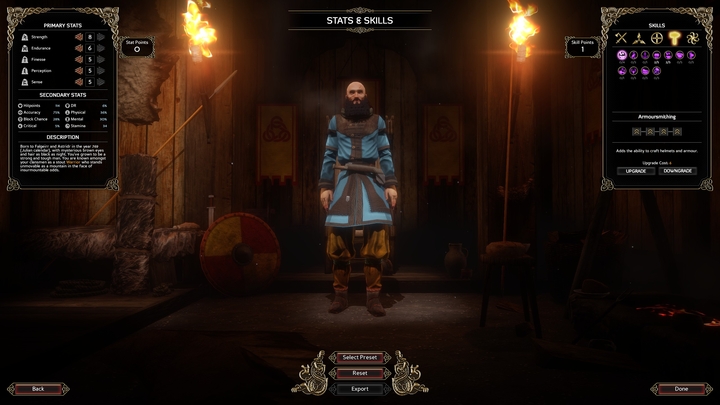
I wish I could spend more time with the alpha version – I found the story really compelling: not from the get-go, but gradually, slowly beginning to appreciate the dialogues, which are really abundant, or the emphasis on difficult decisions. For example, in order to get to an ancient tomb, I could either butcher the people protecting it or agree to make a human sacrifice to appease the underworld deities – I could choose one of my comrades or three random slaves. There were many such moments in the initial hours of the game.
My ship sails on
Contrary to popular belief, the Vikings didn’t really wear horned helmets – this vision is the result of 19th-century romantic painters’ imagination. There was some ceremonial headwear with horns, but it wasn’t used in combat (since it’s not very convenient). Expeditions: Viking has a historical edge to it, so there are no dudes with horns on their helmets.
A compelling plot is a great advantage of any RPG, but the mechanics are equally important. Generally, this game is pretty much Expeditions: Conquistador, only polished and more complex. It’s a tactical RPG, where we explore areas in real time (the improved movement mechanics are a welcomed addition). Should we get into trouble during the exploration of cities, villages or forests, or a conversation with an NPC, a clash will break out: a hex grid will appear on the map, and the gameplay will go into turn mode.
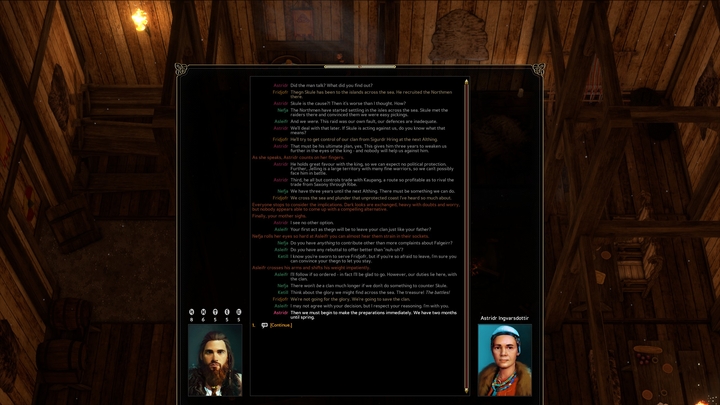
Combat in Expeditions: Viking brings to mind the Jagged Alliance or XCOM series – at least in some aspects, such as the cover system, movement points, or the high importance of outflanking the opponents. What distinguished Viking among the mentioned games is its simplicity – in practical terms, the title by Logic Artists is closer to the similar, however more fantastical, Banner Saga. We lead a handful of warriors (in theory, during exploration the band can’t be bigger than five people, but sometimes additional characters will join us), each of whom has two action points – we can move and attack, or use both points to reach a further hex. The characters have five basic stats (e.g. strength and stamina), different skills (such as stunning, or firing two less accurate shots during one turn); there’s also a shield system that absorbs damage. Simply put – it’s a garden-variety tactical RPG. The combat failed to amaze me – it was just okay. Even if the devs manage to get some things fixed, the combat will not be the game’s biggest asset.
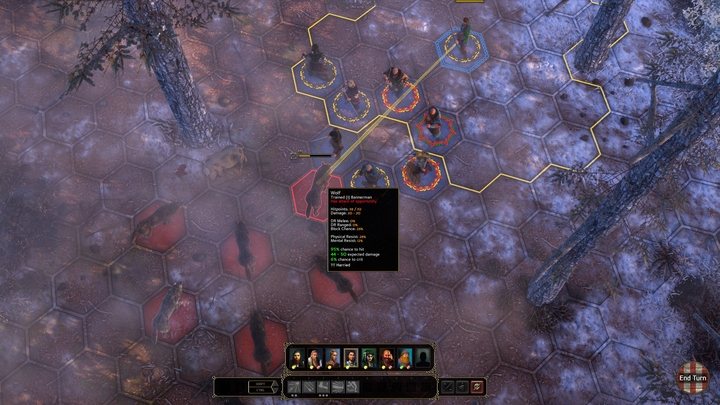
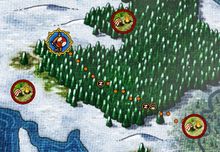
The camping system is designed in an interesting manner: all the characters become tired over time, so it’s mandatory to get some rest in one of the campsites, which are marked on the campaign map. After reaching one of those, the player can give different tasks to each party member – order them to hunt, guard the camp, cook or heal others. It takes some figuring out to be able to have the necessary things done and allow our men to rest at the same time.
When my protagonist was injured (which is commonplace – initial fights are kind of hard; I had to repeat a couple of them), it took several days and two nights at the camp for him to recover. During this period of convalescence, he dealt lower damage.
Looks like Banner Saga got a makeover
A couple of hours is not much when becoming familiar win a complex RPG, but enough to briefly evaluate its pros and cons. What I liked the most about Expeditions: Viking were the NPCs. The members of the party had their own characteristic features, and their loyalty and trust was earned in different circumstances – thanks to this, I developed a bond with the fearless Gunnar, originally a leader of a hostile raid; the superstitious witch Roskva, or the honorable shieldmaiden Nefja. These characters have their own outlook and they often break into conversations – they aren’t mere pawns on the battlefield. It reminds me of Baldur’s Gate, where the NPCs were greatly written as well. Since we’ve mentioned the venerable RPG from BioWare, let’s emphasize that there are more meeting points than that; for example, looting stuff from barrels or crates scattered across the maps (the objects are highlighted if you press Alt). The dialogue system, which is a very important element of the game, is also similar.
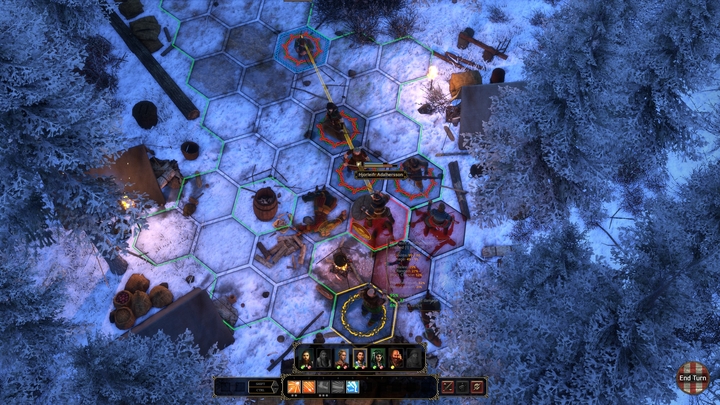
The historical flavor of Expeditions: Viking looks pretty believable. The artwork accompanying the loading screens are lovely, and the music introduces the right mood (there could be more tracks, though). But what I liked the most is how the devs tackled the problem of realism: the fact that there’s no magic in the game doesn’t mean that there won’t be powerful swords or some supernatural themes. “How come?”, you might ask. Let me explain: the devs introduced a faith system – the kind of regular religious beliefs that the mankind has exhibited since, like, forever. The principle is simple, and pretty awesome, too; if a character deals critical damage a couple of times in a row, they will believe that the weapon they wield is special, hence they will feel more sure with it – in the mechanics department, this will translate to more damage dealt.
I encountered only one supernatural threat, but it was rather neat too – I don’t actually know what had happened in the tomb I visited (I failed the perception test), but judging by the dazing smell that filled the air and psychedelic colors filling the screen, I would assume that my characters saw a lot more than there was going on in reality. The fact that the devs decided to go for more realism makes Expeditions: Viking stand out among the slew of games full of fireballs, enchanted swords and other fantastical features. And that’s a great thing. The tough decisions are another cool thing on the list. On many occasions, players will be able to make ambiguous and significant choices that will impact the story in its entirety. Finally, I also appreciated the complex character development system and the number of skills that can be allotted to each of the heroes.
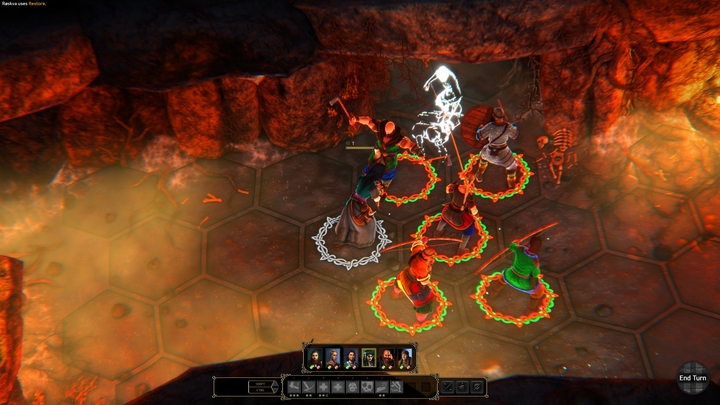
Unfortunately, the “indieness” of Expeditions: Viking is pretty conspicuous – as is the limited budget. The crudeness of the graphics is almost striking – the visuals are far from impressive and the camerawork is sometimes inconvenient. The game could also use the ability to skip the animations of movement and attack – while they do look spectacular thanks to motion capture, they become a nuisance after a while as they last a bit too long. Sometimes the quests are also insufficiently explained. Example? I once tried to talk to a character at his home, but I wasn’t able to, even though he was there. It turned out that I actually had to go to a nearby forest, where the character joined me, and decided I was worthy of a conversation. Quite odd.
Ready your weapons!
The version of Expeditions: Viking I played was only a content-limited demo. Some skills were unavailable; I had virtually no opportunity to develop the village either, and that is one of the most interesting strategic elements of the game. My adventure ended just before the first overseas expedition, during which there would be plenty of fighting, looting and trading. Should all of these things be as enjoyable as the first couple of hours were, I have no doubt that the game will hit all the right notes.
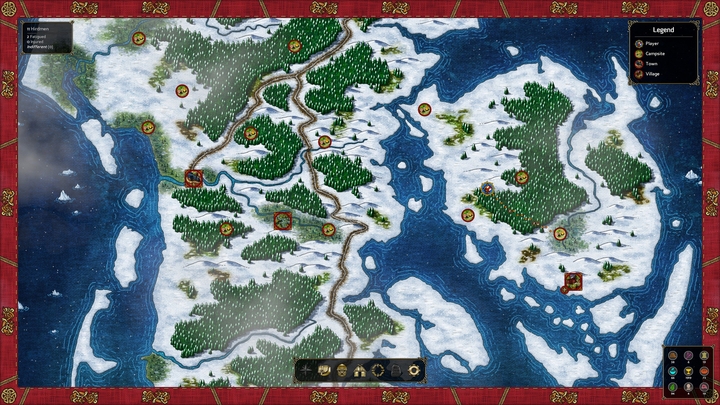
Expeditions: Viking is one of the games that look totally unimpressive at first glance. The roughness caused by low budget or the complicated mechanics can initially deter some players. It’s hard to say whether the combat system won’t prove repetitive and tiresome in the long run – as was the case in Conquistador – but after a couple of hours with Viking, I’m very curious what the future will bring… The adventure in medieval Denmark made me install Baldur’s Gate again. This may be a hefty comparison, but it’s not groundless. The Danes from Logic Artists borrowed a couple of ideas from the classic RPG. And they’re entitled to do so, too: Baldur is a Norse god after all.
